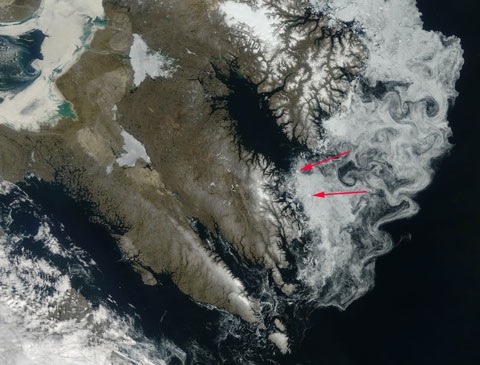NASA’s Earth Observatory is without doubt one of my favourite web sites. As I write, the above view of sea ice off Baffin Island (or a version of it) is their Image of the Day, and aside from the obvious beauties of the swirls of melting sea ice (memorably described in a comment at RealClimate as “frappucino”), I reckon you can make out the two chunks of last year’s Petermann Ice Island that I blogged about last week. My two red arrows mark the huge relict chunks of ice shelf. Click on the image (or here) for the full NASA version (about 3.5MB), and then go and look at the icebergs pouring out of the fjords on Greenland’s west coast (top right of the big picture). Dramatic and lovely, and frightening at the same time.
In other Arctic news, there are a new set of forecasts for this year’s minimum at the SEARCH Sea Ice Outlook site: most teams are picking a result somewhere between 2007 and 2008, but two of the sea ice modelling efforts are still suggesting a new record is possible. The NSIDC’s July 22nd update notes that 2009’s melt is now running ahead of 2008, and looking at their daily graph of extent, the current rate of melt seems to be faster than 2007. This has prompted some speculation about when the NE and NW Passages might open. Scanning the Cryosphere Today and University of Bremen maps, it looks as though the NE Passage (above Russia) might open soon. Blue colours on the CT image correspond the ice swirls on the NASA image above, and there’s still plenty of melt season to run. The NW Passage doesn’t look as sure a prospect: I think it could open, but perhaps only on the northern route. We live in interesting times…
Plus: great images of the Petermann Ice Tongue from the Greenpeace science team up there at the moment at the Guardian and Discovery Channel. Not to be missed.


 New Zealand agriculture is doomed and the country will go bust if it adopts measures to restrain carbon emissions, claims
New Zealand agriculture is doomed and the country will go bust if it adopts measures to restrain carbon emissions, claims 
 “It’s a strange, evil, gorgeous, horrible, fantastic place,” calls out photojournalist
“It’s a strange, evil, gorgeous, horrible, fantastic place,” calls out photojournalist